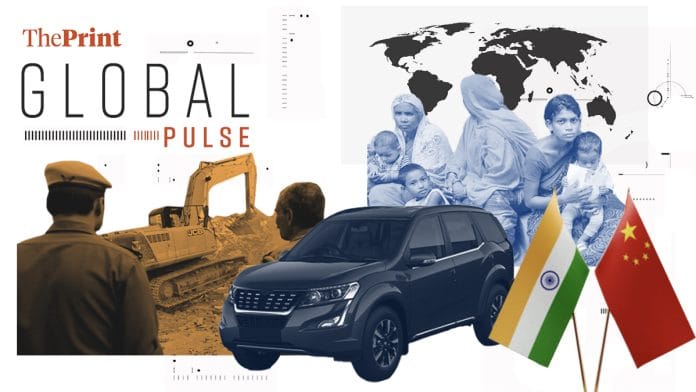New Delhi: The Achilles’ heel of India’s China policy is the fact that India sees China as both a security threat and an economic boon—and this dissonance will eventually hurt India, write Harsh V. Pant and Kalpit Mankikar in a long essay in Foreign Affairs. Economic dependence on Beijing makes New Delhi extremely vulnerable, they write.
“Indian leaders, like many in other countries, have long separated matters of national security and economic growth. But they are inextricable,” the piece opens.
India’s foreign policy stance towards China has been to “discourage Chinese adventurism” in the region, the piece says. But now in his third term, Prime Minister Narendra Modi is adopting a more assertive posture towards Beijing—the Indian government is growing closer to Taiwan, for example, and signing agreements on labour mobility and semiconductor manufacturing. Another example is the Indian government approving a US congressional delegation’s visit to the Dalai Lama, who lives in exile in India. A third example is India sending BrahMos missiles to the Philippines amid its dispute with China in the South China Sea.
But this kind of assertive stance seems to be missing when it comes to economic engagement, the piece points out. The Indian manufacturing sector is still dependent on Chinese goods and expertise, even launching a portal to expedite visas for Chinese professionals.
One of the suggestions the piece puts forward is for a ‘ministry of economic security’, which should assess the scale and scope of China’s economic involvement in India and find ways to “protect India from the risks of this engagement”—this could help India use its economic strength to bolster its capacity to protect itself.
But the current situation—in which India depends on China for components and equipment—holds India hostage to price gouging.
“Giving leeway to China in the economic realm will have several other costs: it tarnishes India’s image as a rising power that can withstand Chinese coercion, undercuts the notion that India can serve as a bulwark against Beijing’s expansionism, and threatens initiatives that include India in the task of rebuilding supply chains outside China,” the piece says. All this is to India’s “inevitable detriment”.
Security and economics cannot be put in silos, write Pant and Mankikar. “It will not be easy to establish India’s economic security in the shadow of its giant northern neighbour,” the piece warns. “But Modi can use his third term to make this shift. After ensuring that Beijing gets the message clearly that New Delhi will forcefully push back any Chinese aggression, he must find consistency in his China policy and break the silos of business and national security.”
If he doesn’t, Pant and Mankikar think Modi’s desire for a larger role on the global stage will be overshadowed by China “both at the border and within India”.
The Economist has a slightly sunnier disposition to India’s economic prowess. “All over India a growing middle class is rushing out to buy the ultimate expression of individualism,” it says—cars.
Car ownership per 1,000 people has doubled from 17 to 34 between 2012 and 2022, pointing to not just a love affair with cars, but an expansion in wealth to be able to buy them. The biggest shift that proves this is the fact that more and more Indians are buying SUVs.
SUV sales are booming in India. The state of the roads—both the terrible ones and the newly constructed motorways—have aided this phenomenon. Another reason, The Economist says, is because SUVs are safer and the Indian consumer seems to prioritise safety more now. And thirdly, value over cost: “Indians are increasingly willing to spend more for a better experience”. This is also seen in the fact that cheap mobile phones are disappearing from the Indian market while iPhone sales are soaring.
“A decade ago, simply owning a car conferred status. That is no longer enough. Today it is the car’s make and features that mark out its owner,” The Economist observes.
The BBC has a more sobering report on India’s development. New research, it reports, shows that decades of caste discrimination have contributed to India having higher levels of child stunting rates than across Sub-Saharan Africa.
“Official data shows that more than 35 percent of India’s 137 million children under five are stunted, with over a third also underweight. Globally, 22 percent of children under 5 are stunted,” the report says, quoting research by academics from Ashoka University and Monash University, Malaysia. “The economists found that children from higher-ranked, non-stigmatised caste groups in India stood at 27 percent—markedly lower than the Sub-Saharan African rate.”
This is offset by the fact that children from higher-ranking caste groups are less likely to experience stunting.
The BBC describes how the high stunting rates of Indian children have sparked debate in the past. Some economists argue that Indian children are genetically disposed to be shorter, while others say that improved nutrition has closed the gaps thought to be genetic. Adivasi children are more likely to be malnourished, however, and are also more likely to experience stunting.
“But what is clear is that children from poor families, with less-educated mothers, or from marginalised groups, are especially vulnerable to stunting in India,” the BBC says. Both social identity and child nutrition play a role.
Meanwhile, the New York Times reports on the Supreme Court’s outlaw of bulldozer justice. “The bulldozer has become a political symbol in India, especially in states governed by Mr Modi’s Bharatiya Janata Party,” it reports. The ruling is a “step toward combating the discrimination that has become commonplace against Muslims in recent years in India,” it adds.
Also read: Stock market revolution, GDP race with Japan. Global attention on Indian economy, with some caution






